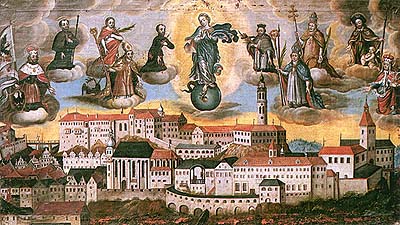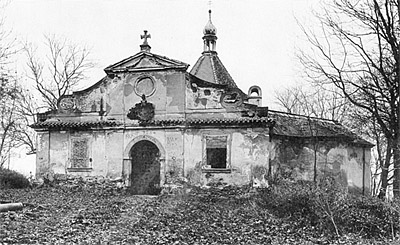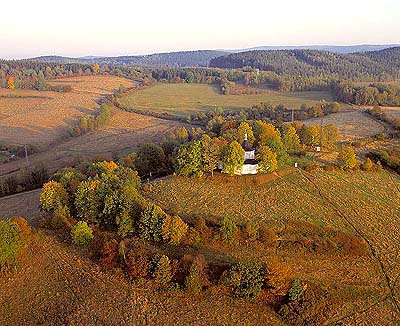Chapel on the Mountain of the Cross in Český Krumlov
Building Description
This eight-nave chapel of Our Lady Dolorous and the Holy Cross
built in 1710 is vaulted by an eight-part arch and covered with a
tent-like roof topped with a lantern and a double cross. The
interior is enlightened by two basement windows and two first-floor
windows. The entrance to the chapel leads through the main northern
and a side western gate. The eight-nave gallery is vaulted by an
arch. Southern outpost wing with a double-window axial entrance is
crowned with a wide voluta shield of a triangle extension topped
with a cross. The northern ambit access passes through a
double-shoulder staircase.
Historical Development of the Building
The sensitive perception of the Baroque period was very attracted
by such places suitable for building either places of pilgrimage or
single pilgrimage buildings. Such ambitious esthetic shaping of the
Czech landscape and its adoration association with an intensive
Madonna cult often applies a "Gothic mountainous motive where God
lets us know him better". This method of perception resulted in the
Chapel on the Mountain of the Cross (619 m above sea level)
south-east of Český Krumlov. In 1658 (or in 1650), a Jesuit
preacher Michal Koppe had a so-called Spanish wooden cross
allegedly containing a small part of the Holy Cross erected there
in order to have the town protected against unfavorable weather and
natural disasters. Actually, it was a type of the very popular
"Wetterkreuz" (from German, meaning Weathercross) which can be
found throughout all of Central Europe and Danube region. In 1701
when the cross had to be repaired, a tree which was cut for that
purpose miraculously fell apart into three pieces. In addition to
the cross made out of those three pieces, a small chapel was built
from remaining wood. A certain burgheress from Krumlov decided to
place three pictures of the Cross Path by the chapel.
In the meantime, the inhabitants had ambitions to build a bigger
brick chapel. It happened with the cooperation of the municipal
council, prince Johann
Christian I. von Eggenberg and his wife in 1710 when the chapel
was consecrated by a Jesuit College rector from Krumlov (September
14, 1710). The project of the chapel construction was compiled by
Jan Dominik Spazzi, an Eggenberg builder. Many artists and
craftsmen in particular from Cesky Krumlov  participated on the
chapel's equipment and finishing. Immediately after the chapel's
consecration, however, it turned out that the chapel was too small,
so the prince decided to build an eight-nave ambit right away. The
Loretta chapel in Prague was used as a pattern for it. At the same
time, missing parts of the Cross Path were planned to be added and
were mentioned already in 1717. After the prince's death (December
14th, 1710), the municipal council took over sponsorship of the
ambit construction, and the whole project was finished only in
1726. A stone-cut three-cross Calvary stands in front of the main
entrance, and two columns decorated with sculptures of Christ the
Sufferer and Our Lady Dolorous were situated in front of the
southern entrance. The ambit was decorated, as was the chapel, by
paintings, altars, sculptures and hanging pictures. A very small
modest hermit's dwelling was built inside in 1758.
participated on the
chapel's equipment and finishing. Immediately after the chapel's
consecration, however, it turned out that the chapel was too small,
so the prince decided to build an eight-nave ambit right away. The
Loretta chapel in Prague was used as a pattern for it. At the same
time, missing parts of the Cross Path were planned to be added and
were mentioned already in 1717. After the prince's death (December
14th, 1710), the municipal council took over sponsorship of the
ambit construction, and the whole project was finished only in
1726. A stone-cut three-cross Calvary stands in front of the main
entrance, and two columns decorated with sculptures of Christ the
Sufferer and Our Lady Dolorous were situated in front of the
southern entrance. The ambit was decorated, as was the chapel, by
paintings, altars, sculptures and hanging pictures. A very small
modest hermit's dwelling was built inside in 1758.
The area experienced multiple renovative interference during the second half of the 18th century. The biggest changes applied to the Cross Path. Six new chapels decorated by paintings of František Jakub Prokyš were erected instead of the sculptured old ones during 1740 and 1753 - 1755. Although they are much younger, their style is similar to the Cross Path in Římov.
The chapel was closed down in August 24,1787, and sold in auction to Karel Neumüller, a burgher from Cesky Krumlov, who opened it to the public again in 1794. His daughter Kateřina had the whole area expensively repaired in 1850, but she did not manage to avoid some negative arrangements (for example the shingle roof was replaced by tin). The unfavorable economic situation of the family then caused dilapidation of the chapel and it seemed that it would vanish completely after 1918. Fortunately, Terezie Schwarzenberg bought the chapel in 1928 and takes credit for the general renovation of the place of pilgrimage. In was consecrated again in 1933 by a bishop from České Budějovice. After the chapel survived the second World War, it was looted and destroyed in the course of the fifties. Remains of an ancient case was transferred to the Castle in Cesky Krumlov in 1962. Devastation went on and the chapel's condition was getting worse and worse. Based upon a decision of the District Council in Česky Krumlov from 1990 - 1991, a rescue of the whole area has started. In September 14th, 1991, the chapel was opened after a demanding reconstruction respecting the authentic historical values, and after 281 years was consecrated again. The official inspection in 1992 put an end to the reconstruction period.

|

|
Significant Architecture Elements
In terms of style, the sacral area on the Mountain of the Cross is
very retarded and even rustical which utterly corresponds with the
local art works of the first years of the 18th century. Spazzi
utilized a formal pattern that reflected the manner of early
Baroque architecture. Nevertheless, some details, for example the
entrance portals and their supra-ports, remind us of the actual
time of its origin. On the other hand, the Cross Path chapels
disclose the great invention of their author. Thoughts of a radical
Baroque period transformed into a rather Rococo calmed-down
expression reverberate there.
Spiritual Dimension of the
Chapel As many similar buildings
in Bohemia, the chapel's composition has been based upon a typical
Baroque numerical symbolism. It is suggested that the early cult of
the Cross and Christ's suffering was pushed away by the adoration
of Mary. The inner diameter has about 7 meters which symbolizes the
seven pains of Virgin Mary: 1) Christ's circumcision 2) Escape to
Egypt 3) Baby Christ in the Church 4) Christ falls under the cross
5) Erection of the cross with Christ on it 6) Removal of the cross
7) Christ's burial. The chapel and ambit octagonal shape
symbolizes eight blessings Jesus defined in his sermon on the
mount. Six well-preserved Rococo chapels along the Cross Path again
refer to the seven pains of Virgin Mary because the seventh chapel
was the chapel on top of the Cross Mountain whose main alter used
to be decorated with a figure of Christ in his grave during the
Easter celebration. The name of the Cross Mountain or Calvary
Mountain comes from a Latin term locus Calvariae, i.e. Golgotha (=
skull in Aramic language). According to the Gospels, Jesus and two
thieves were crucified on top of Golgotha Mountain right behind the
walls of Jerusalem. It was a usual habit to use topographic
analogies taken out of the New Testaments.
As many similar buildings
in Bohemia, the chapel's composition has been based upon a typical
Baroque numerical symbolism. It is suggested that the early cult of
the Cross and Christ's suffering was pushed away by the adoration
of Mary. The inner diameter has about 7 meters which symbolizes the
seven pains of Virgin Mary: 1) Christ's circumcision 2) Escape to
Egypt 3) Baby Christ in the Church 4) Christ falls under the cross
5) Erection of the cross with Christ on it 6) Removal of the cross
7) Christ's burial. The chapel and ambit octagonal shape
symbolizes eight blessings Jesus defined in his sermon on the
mount. Six well-preserved Rococo chapels along the Cross Path again
refer to the seven pains of Virgin Mary because the seventh chapel
was the chapel on top of the Cross Mountain whose main alter used
to be decorated with a figure of Christ in his grave during the
Easter celebration. The name of the Cross Mountain or Calvary
Mountain comes from a Latin term locus Calvariae, i.e. Golgotha (=
skull in Aramic language). According to the Gospels, Jesus and two
thieves were crucified on top of Golgotha Mountain right behind the
walls of Jerusalem. It was a usual habit to use topographic
analogies taken out of the New Testaments.
 Three feasts where the
Masses were to be read reflected the chapel consecration as well.
St. Cross Discovery (May 3rd), St. Cross Raising (September 14th)
and Divine Mother Dolorous (September 15th) were to be celebrated
each year. Lists of Masses celebrated in the chapel during 1711 -
1717 proved that in those days sung Masses were celebrated here.
Besides these, other irregular Masses took place here (annually 41
- 24 times, and even 64 in 1717) especially in May (which was
consecrated to the Virgin Mary), in April, June and September; very
seldom during the winter season. Masses were celebrated mainly by
St. Vitus Church curates and sometimes by Minorites and Jesuits,
and very seldom by Cistercians, and once there was a Serviette monk
from Nové Hrady and two foreign parish priests and a member of
Petrine Order. The first two years the St. Cross Discovery Masses
were celebrated by a prelate from Cesky Krumlov. Nevertheless,
people were visiting the Cross Mountain even outside the times of
the Mass celebrations. Whenever the curate in charge saw many
people climbing up the hill on a summer Sunday afternoon, he was
obliged to open the chapel for them.
Three feasts where the
Masses were to be read reflected the chapel consecration as well.
St. Cross Discovery (May 3rd), St. Cross Raising (September 14th)
and Divine Mother Dolorous (September 15th) were to be celebrated
each year. Lists of Masses celebrated in the chapel during 1711 -
1717 proved that in those days sung Masses were celebrated here.
Besides these, other irregular Masses took place here (annually 41
- 24 times, and even 64 in 1717) especially in May (which was
consecrated to the Virgin Mary), in April, June and September; very
seldom during the winter season. Masses were celebrated mainly by
St. Vitus Church curates and sometimes by Minorites and Jesuits,
and very seldom by Cistercians, and once there was a Serviette monk
from Nové Hrady and two foreign parish priests and a member of
Petrine Order. The first two years the St. Cross Discovery Masses
were celebrated by a prelate from Cesky Krumlov. Nevertheless,
people were visiting the Cross Mountain even outside the times of
the Mass celebrations. Whenever the curate in charge saw many
people climbing up the hill on a summer Sunday afternoon, he was
obliged to open the chapel for them.

|

|
Another attraction of the chapel were two "miraculas". It meant a small new Spanish-style crucifix made out of the miraculous tree from 1701 (see above) with a tin painting of the crucified Christ attached to it (probably from 1460). According to the legend, the tin crucifix is said to come out from a hammer hit to the metal done by a kettle-maker who had bought it from a Jewish merchandiser. Second "miraculum" was a painting of Mary dedicated to the chapel by Jan František Antonín Tschernichen, a typist from Cesky Krumlov who had also taken a significant credit for the chapel's origin.

Obviously, the chapel belonged to the spiritually strong places of pilgrimage where miracles and prayers were expected to come true. (see Places of Pilgrimage in the Český Krumlov Region). Such events had to be recorded by a volunteer town counselor who was active as a church father and was caring for the good chapel condition and its bookkeeping. Then the miracles had to be proven in town hall under oath in the name of God. The importance of Křížová hora continued as a place of protection against bad weather. A municipal request addressed to the prelate preserved from 1713 asking him to allow processions pleading for good weather going to the Minorite Monastery in Český Krumlov after he had alternately been going in the previous two days to the worships in Kájov, Zlata Koruna, Černice and Přídolí.
(jh)






